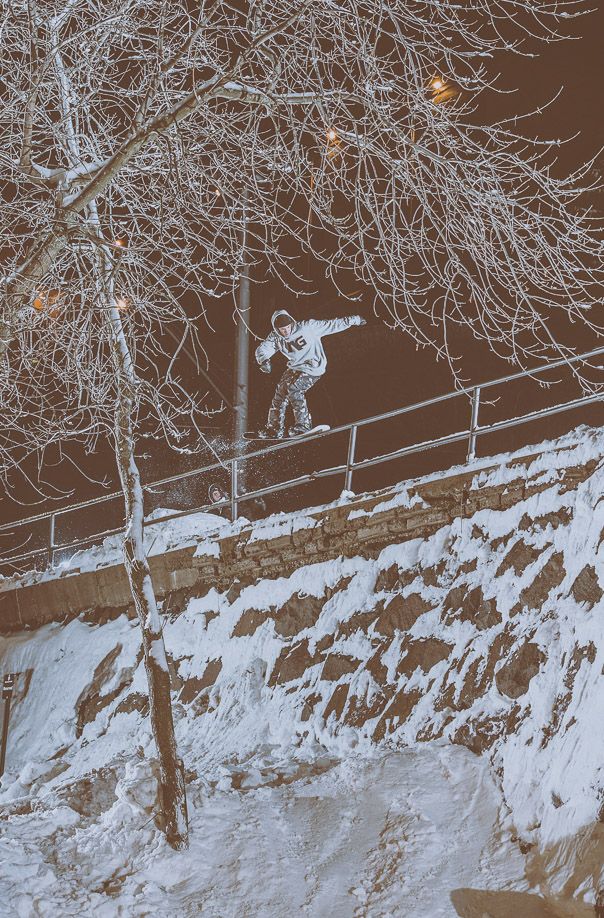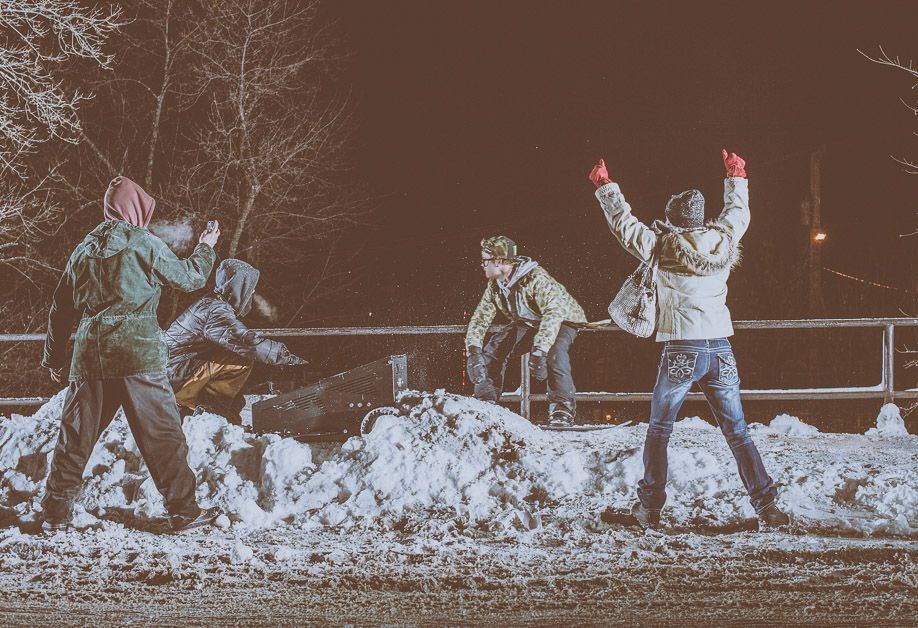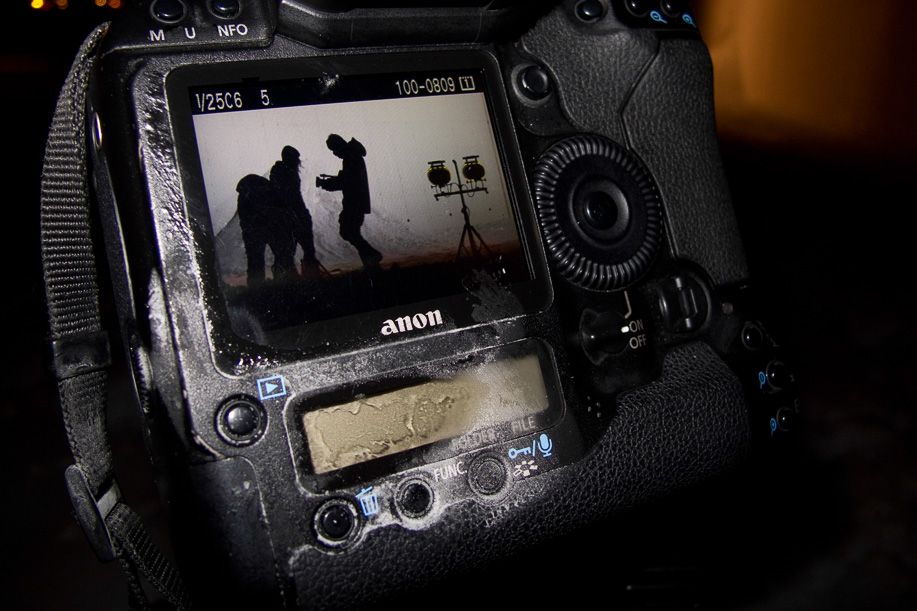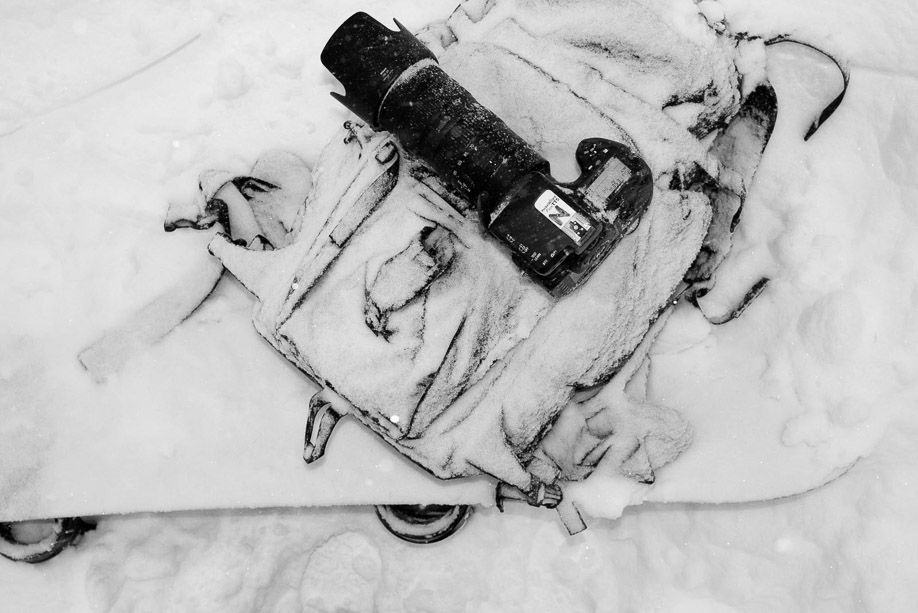As with any winter photo assignment, staying warm and dry is a big part of bringing home the images you’re assigned to gather and those for your personal portfolio. Body warmth can be achieved through proper layering, but we’re here to talk about using camera equipment in the freezing cold temps, what to do while shooting, after the day is done and how to be prepared every day, as I did during an assignment to Duluth, Minnesota in January.
We had a one-week period to explore and create as many snowboarding obstacles as possible around the city of Duluth, which is located in Northern Minnesota, sitting along the edge of Lake Superior. The climate in his part of the world can be described in many ways, descriptions usually containing the word ‘freezing,’ as artic air swoops down from the North to put a chill in all who tread that way.
With low-pressure systems rolling through at a steady pace dropping feet of snow every winter, Duluth can hold snow for most of the cold season, providing snowboarders with an endless array of creative opportunities. The photographer’s job is to be ready with his equipment, composition and stoke when the riding starts to happen.
First, cold temperatures have a negative effect on battery life, meaning they won’t last nearly as long when compared to the summer season. I use two simple techniques to combat running out of juice when shooting photos, with the first being carrying extra batteries, and the second is charging them up every single evening. What it comes down to on any photo shoot, no matter the weather, the conditions, the length of time in the field, you’re not allowed to run out of battery life if subject matter is still in front of your lens. Don’t be the guy or girl who ran out of juice (or card space), not good if you want the telephone to keep ringing.
If you’re using a D4 or 1Dx style camera, always carry one spare Lithium-Ion cartridge, if you’re shooting with a D810 or 5D model, think about two to three extra Lithium-Ion batteries, depending how long you’re staying out in the cold. Our snowboarding missions keep us outside for ten to sixteen hours a day, so extra batteries are essential to your kit. You can also explore incorporating a car charger into your bag if you have a vehicle at your disposal, or maybe you’re shooting at a location that has a power supply, so you’d simply need your camera’s wall plug-in charger.
Moving on from the battery issue, you need your gear to perform as well in the freezing temperatures as they would in mild temps during spring, and that simply means having them clean and dry when you head out on the day’s mission.
Camera and lens combinations have no problem functioning in the cold, never have I had a problem no matter what the temperature, I actually believe this type of equipment thrives under these freezing conditions! It’s when you reintroduce the equipment to a warm climate, like the interior of a heated vehicle or your hotel room at day’s end that produces condensation.
Condensation is no problem if handled properly, so I’ll start with my ‘in the field’ advice. If you’re going from location to location in a warm automobile, leave the camera and lenses in the bag zipped up. Upon arrival get the bag out, open it up, gear is acclimated and ready to go. If you pull the gear out in the heated interior, you’ll immediately get condensation on anything that’s glass, followed by the exterior of the camera and lens. At this point you would need to wait out the condensation as it dissipates (acclimating to the interior temperature), which takes a fair bit of time, or you can short cut this process by wiping off the glass, but who wants to clean their lenses multiple times per day while on a shoot? Nobody, it’s completely unnecessary, and, cleaning off condensation under these circumstances is going to leave behind wipe marks, guaranteed. We’ve all made the mistake. If you catch yourself taking out the camera gear in the car to review the shots, you might be able to reacclimatize the gear quickly by putting it back outside, works from time to time.
Do yourself the favor and review your photos out in the cold where you shot them, skip the condensation nightmare, don’t want to be the photographer the talent is waiting on at the next location to get their photo gear in order.
Part two is talking about what to do with your gear at day’s end, which weighs heavily on the importance factor of a successful following day. Once you get back to the hotel, set the bag down, unload the camera and lenses, leaving ALL lens and body caps on. Let the equipment start the warmer climate acclimation process with the caps on for thirty to forty-five minutes. At this point, pop off the lens and body caps and let the equipment continue its process of drying, for you really don’t need to do anything unless the gear is dripping wet, which really doesn’t happen that often (if it does, grab a soft bathroom towel and lightly dab the exterior water droplets only). You may or may not see some condensation on the lens glass, regardless, let it be, it will go away like it was never there. After the equipment sets overnight, you’ll wake up the next morning to perfectly dried out gear, like its never seen cold temps before.
Part three revolves around the camera bag, easily overlooked when thinking about drying the gear in preparation for the following day’s mission. A camera bag is comprised of all sorts of materials that aren’t waterproof, they may be water resistant, but moisture is going to get in there in a number of ways throughout a long day of shooting in the cold. This is absolutely no problem if you dry the bag each evening just as you do with your boots and camera gear. If you fail to heed the warnings, you may be caught out in the field with the evil fog circle.
Here’s how it happens: if you go out the next day with dry gear and a moist camera bag interior, thousands of tiny little water molecules are slowly going to creep into the inner workings of your lenses since they’re surrounded in this cozy, somewhat damp interior, creating what’s known as the ‘fog circle.’ Once you’re out on location and the fog circle hits, you can’t do anything to combat the problem, it’s there until that lens is dried out one-hundred percent, which means you just lost a lens choice for the day. I’ve witnessed photographers (and filmers) use a lighter to create heat, or they’ll shake the lens around in some sort of ‘man, I hope this works dance,’ and finally they’ll try and hold the lens towards the sun to bake it away real quick, which admittedly works for a second, until you go to use the lens in the non-sun direction, and the fog comes right back!
The name of the game is drying out everything overnight you used that day in the cold; it’s just the way it goes. Be the photographer who is ready for another long day of shooting, not the lens man ill prepared and missing shots, not to mention sending out the vibes to your talent that your gear isn’t in order… That’s never reassuring to the guys and girls risking their health and well-being in the name of getting photos for you.
Blotto
www.blottophotto.com
Instagram: @deanblottogray



















